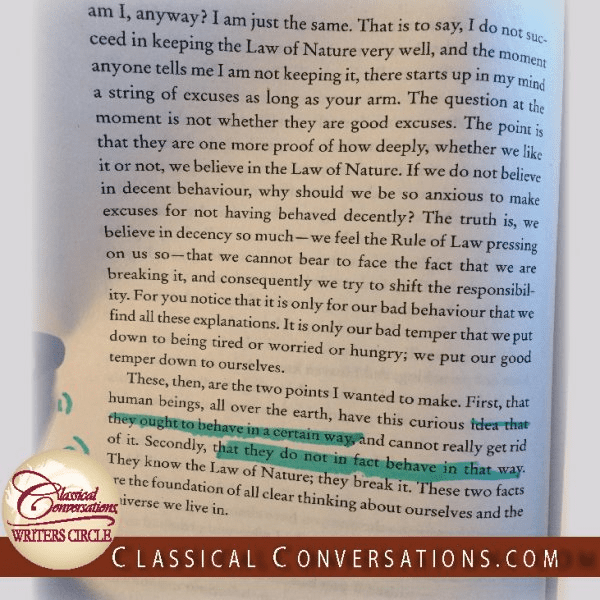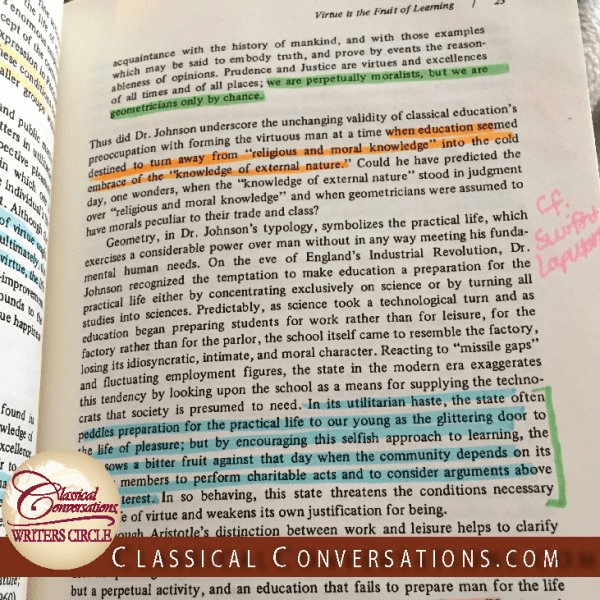When it comes to encouraging lifelong learning, the most important skill we can give our students is that of reading well. If they learn to read well, they can tackle any topic on their own long after they leave our homes.
Enlightenment is achieved only when, in addition to knowing what an author says, you know what he means and why he says it.”
— Mortimer Adler, How to Read a Book
The 4-Step Highlighting System for Annotating Any Book
When I was a high school and college student focusing on literature, I learned to annotate my books using a pencil. I would underline statements I wanted to remember, put a question mark in the margins for items I needed to come back to, circle words with difficult or unknown meanings, and number lists that were essential to the plot or the thread of an argument. Studying this way, I was learning outside the classroom, and I was learning directly from an author, perhaps even one who had long passed. Using these techniques, I could research classical education, re-learn chemistry and biology, and engage with ancient literature and philosophy.
Since then, I have learned a new highlighting system for marking up my books. I now use the standard five-color package of highlighters to indicate different kinds of things in my books. I also encourage my Challenge students to incorporate this system into their studies. Here’s a quick look at this highlighting system for marking up any book.
Some books are to be tasted, others to be swallowed, and some few to be chewed and digested.”
— Francis Bacon
1. Skim the Book with a Pink Highlighter
Use the pink to highlight names, places, and dates. If you’re reading history, you’ll have an instant timeline of the important people and events. If you’re reading science, you’ll have a good list of the important discoveries and their discoverers. If you’re reading literature, you will have a ready-made character list. If you’re reading an argument (for instance, a book advocating classical education) you will have a list of other writers who have something to say about this subject. You’ll know where to go to research further.
Example: I recently read Norms and Nobility by David Hicks. In Chapter 1, I used pink to highlight Aristotle, Plato, Samuel Johnson, Cicero, Immanuel Kant, Hannah Arendt, and Isokrates. These are all people I might need read in the future. It also gives me a sense of the kinds of authorities to whom David Hicks turns.
2. Mark “Notable Quotables” with the Blue Highlighter
The blue highlighter can be used to mark things that you would want to quote to a spouse or a friend. These are the moving quotations that you would copy into a commonplace book or use at the opening of a speech. They are the revelations that you want to remember for the rest of your days and share with others. We often recommend that you start with pink and then progress to blue. Then, you can start a great discussion with your student simply by asking, “What are your blues in this book?”
Example: In A Tale of Two Cities, one character goes to the guillotine in the place of another. On the way to his execution, he encourages a poor young girl. I marked part of her final speech to him in blue: “But for you, dear stranger, I should not be so composed, for I am naturally a poor little thing, faint of heart; nor should I have been able to raise my thoughts to Him who was put to death, that we might have hope and comfort here to-day. I think you were sent to me by Heaven.”
3. Use the Green Highlighter to Get a Sense of Structure
I find the green highlighter especially helpful when I am reading nonfiction. Use the green to mark numbered lists. For example, the author might be offering a chapter-long explanation of the major causes of the Civil War. If you mark each of them in green, you will have an outline of the author’s thesis. If you are reading science, you might use green to mark the three characteristics of acids or bases or the major organs in the respiratory system or the process that results in complete combustion. As you are teaching yourselves and your kiddos to use the green highlighter, be sure to look for clue words like ordinal numbers (first, second, etc.) and ordering words like (next, finally, in conclusion).

Example: In the first chapter of Mere Christianity by C. S. Lewis, he says this: “These, then, are the two points I wanted to make. First, that human beings, all over the earth, have this curious idea that they ought to behave in a certain way, and cannot really get rid of it. Secondly, that they do not in fact behave in that way. They know the Law of Nature; they break it. These two facts are the foundation of all clear thinking about ourselves and the universe we live in. (The two bold phrases are those I marked in green.) Now, I’m very clear about the first two points that C. S. Lewis will make in his argument. To keep things even more clear, I marked these points with a 1 and 2 in the margins.
4. Note Stylistic Devices With the Orange Highlighter
An important part of a classical education is elocution or style. Therefore, we teach students parallelism, simile, metaphor, and alliteration. We want them to present the truth in a compelling way so that their listeners can understand and be drawn in. Jesus did this over and over with his disciples when He revealed Himself as the bread, the wine, the vine, and the door. In order to develop this sense of style, students need to practice writing with style. They must read copiously and notice the style of other writers. This is where your orange highlighter comes in.

Example: Again, in reading Norms & Nobility by David Hicks with my students, I found that this book is chock full of eloquent insights. Here’s one passage I marked in orange: “. . . when education seemed destined to turn away from ‘religious and moral knowledge’ into the cold embrace of the ‘knowledge of external nature.’”
The orange highlighter helps you to celebrate beauty.
Mastering This Highlighting System
Here are two last quick tips as I close out. First, don’t expect to master this system all at once. Practice with the pink highlighter for awhile, then switch to blue, then finally add green and orange. Second, don’t expect to be perfect. It takes practice to become a careful reader. Give yourself (and your student if they are following this highlighting system) lots and lots of grace.
Not yet a Classical Conversations® member and interested in our community-based approach to homeschooling? We’d love to hear from you! To learn more about us, click here.





